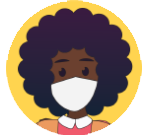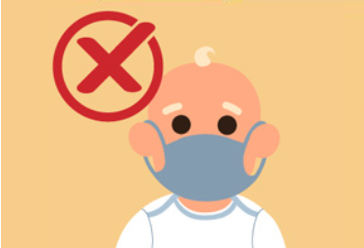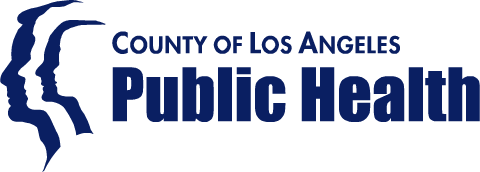
COVID-19
Masks
LA County When You Need to Wear a Mask

There are some instances when individuals in LA County must mask. This includes, but is not limited to:
- As required in the workplace. Requirements may be based on the Cal/OSHA Aerosol Transmissible Diseases (ATD) Standard or workplace-specific requirements.
- As required in healthcare settings by current LACDPH Health Officer Orders.
- If it is required by the site, including some businesses, health facilities, schools, and workplaces.
- If you are sick with symptoms of cold, flu, or COVID-19, or if you test positive for COVID-19 (even if asymptomatic) and must be around others. This is especially important when you are around individuals who are at high risk for severe illness. Wear a mask for 10 days after becoming sick, or if you have no symptoms, for 10 days after you tested positive. You can remove your mask sooner if you have two sequential negative tests at least one day apart. Follow all the instructions at publichealth.lacounty.gov/covidcommunity.
Everyone should consider their own individual risk level when choosing whether to mask. Everyone is recommended to mask in some situations, including:
- If you are exposed to someone with COVID-19, for 10 days from the last day that you were exposed. This is especially important when around those at higher risk for severe COVID-19 disease. Follow all the instructions at publichealth.lacounty.gov/covidcommunity.
- In healthcare settings, when visiting or receiving care.
- On public transit and in transportation hubs, especially during times of increased transmission, including the annual winter respiratory virus season.
- If you or someone you spend time with are at risk for severe illness. You should wear your most protective mask, such as a N95, KN95, or KF94 respirator, when you are indoors in public. This is especially important when you are in crowded or poorly ventilated places.
Know which masks provide the best protection
For a mask to work well, it needs to have both a good fit and good filtration:
- Good fit means that the mask covers your mouth and nose and fits snugly against the sides of your face and your nose.
- Good filtration means the material that the mask is made of blocks airborne particles well. You can get good filtration by wearing a mask that has several layers made of certain specialized materials.
The best mask has a high-quality filter, fits well against your face, and is comfortable enough for you to wear consistently.
For the best protection, wear a well-fitting respirator. If you can't use a respirator, you can make your mask work better by improving the fit and filtration.

Some cloth masks are designed with specialized filter/layers and are tested to demonstrate that they perform at a consistent level. The American Society for Testing and Materials (ASTM) has set a standard (ASTM F3502-21) for barrier face coverings, including cloth ("reusable") masks. The most protective ASTM F3502-21 performance level masks have a particulate filtration efficiency of at least 95%. ASTM F3502-21 performance level ratings for some commercially available face masks are published on the CDC/NIOSH website Barrier Face Coverings and Workplace Performance/Performance Plus Masks. If you are considering purchasing a cloth mask, look for ones with high performance level (≥95% particulate filtration efficiency) and that have been tested by an accredited third-party laboratory.
For detailed information on different types of masks visit:
How to improve the fit and filtration of your mask
- Use a mask fitter or brace; these devices are worn over a medical or cloth mask to reduce the leakage around the edges.
- Knot the ear loops close to the edge of the mask and tuck the excess material so there is no gap. See Knot and Tuck video.
- Choose a mask with straps that go round your head for a tighter fit.
- Wear a mask with nose wires.
- Certain types of facial hair, like beards, can make mask fitting difficult. People with beards can trim them, use a mask fitter/brace, or double mask.
Important notes:
- Double masking does not work with two medical masks because they are too loose.
- Respirators should not be worn with a second mask or a brace/fitter as this interferes with the fit.
Tips to check that your mask fits:
- Check for gaps by cupping your hands around the outside edges of the mask and feel for any air leakages. Make sure no air is flowing from the area near your eyes or from the sides of the mask.
- If the mask has a good fit, you will feel warm air come through the front of the mask and may be able to see the mask material move in and out with each breath.
- If you have to continually adjust your mask, it might not fit properly. Consider trying different types or sizes of masks.
Who should not wear a mask

The following people should not wear a mask:
- Children under age 2.
- People who cannot safely wear a mask, such as someone who is unconscious, incapacitated, or who is unable to remove a mask without help.
- Workers in situations where wearing a mask would create a risk, as determined by local, state, or federal regulators or workplace safety guidelines.
For more information on masks and people with disabilities, including those who are deaf or hard of hearing, see CDC Masks: Special Considerations Section.
More information
CDC and CA State mask guidance websites
- CDC Personal Protective Equipment for the Public
- CDPH When and Why to Wear a Mask
- CDC/NIOSH Respiratory Protection Information Trusted Source (information on respirators)
Additional resources
- CDC/NIOSH Barrier Face Coverings and Workplace Performance/Performance Plus Masks
- CDC Video Instruction to Improve Medical Mask Fit (Knot and Tuck Technique)
- CDC/NIOSH-How to Put on and Take off a Respirator (PDF)
- CDC/NIOSH-User Seal Check (PDF)
- CDC/NIOSH-Fit Testing (PDF)
- CDC Study - Maximizing Fit for Cloth and Medical Procedure Masks to Improve Performance and Reduce SARS-CoV-2 Transmission and Exposure
- CDC Science Brief: Community Use of Masks to Control the Spread of SARS-CoV-2
- Masking Tips for Children (CDPH): English | Español
 Translate
Translate